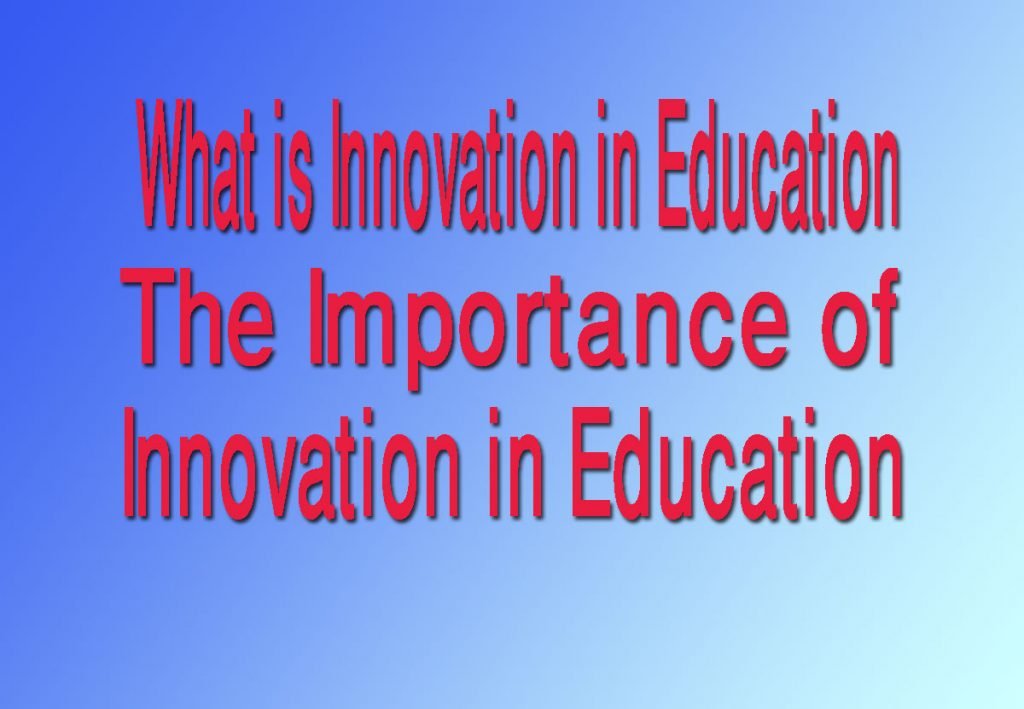Innovative education: Education has always been an essential component of human growth and development. It is a means of acquiring knowledge, skills, values, and attitudes that prepare individuals for the future.
However, in the rapidly changing world we live in, traditional education systems are becoming inadequate in preparing students for the complex and dynamic nature of modern life.
As a result, innovative education has become a necessity. This essay explores the concept of innovative education, its benefits, and its implementation.
Defining Innovative Education
Innovative education refers to a learning process that incorporates creative and unconventional approaches to teaching and learning. It focuses on promoting critical thinking, problem-solving, and collaboration, among other skills, to prepare students for the 21st-century workplace.
It involves the use of modern technologies, such as virtual and augmented reality, online learning platforms, and gamification, to enhance learning experiences.
Benefits of Innovative Education
Innovative education has several benefits for students, teachers, and society as a whole. Firstly, it promotes creativity and innovation. By using unconventional approaches to teaching, students are encouraged to think outside the box, come up with new ideas, and explore different ways of solving problems.
Secondly, innovative education promotes collaboration and teamwork. In today’s world, teamwork is a crucial component of success in various fields. By working in groups, students learn how to communicate effectively, delegate tasks, and respect each other’s opinions.
Thirdly, innovative education promotes the use of modern technologies, such as virtual and augmented reality, which enhance learning experiences. These technologies create immersive and interactive learning environments that help students understand complex concepts better.
Fourthly, innovative education prepares students for the 21st-century workplace. The workplace today requires individuals who can think critically, solve problems, and collaborate with others. Innovative education focuses on developing these skills, making students more attractive to potential employers.
Lastly, innovative education promotes lifelong learning. By encouraging students to be curious, explore new ideas, and learn continuously, they develop a growth mindset that prepares them for lifelong learning.
Implementation of Innovative Education
The implementation of innovative education requires a collaborative effort between educators, policymakers, and stakeholders.
Firstly, educators need to embrace new teaching methods that incorporate creativity, critical thinking, and problem-solving. They need to use modern technologies and tools to create immersive and interactive learning environments that engage students.
Secondly, policymakers need to create an enabling environment for innovative education to thrive. This includes investing in modern infrastructure, such as high-speed internet, virtual and augmented reality tools, and online learning platforms.
Thirdly, stakeholders, such as parents and the private sector, need to support innovative education initiatives by providing resources and creating partnerships with educational institutions.
Examples of Innovative Education
There are several examples of innovative education initiatives around the world. One example is the use of gamification in learning. Gamification involves the use of game mechanics, such as points, badges, and leaderboards, to motivate and engage students in learning.
It has been shown to improve student engagement and motivation, leading to better learning outcomes.
Another example is the use of virtual and augmented reality in learning. Virtual and augmented reality create immersive and interactive learning environments that help students understand complex concepts better. For instance, medical students can use virtual reality to simulate surgical procedures, giving them a hands-on experience before they operate on real patients.
Online learning platforms are also an example of innovative education. These platforms offer flexible and personalized learning experiences that cater to individual student needs. They allow students to learn at their own pace and provide access to a wide range of educational resources.
Challenges of Innovative Education
Despite the benefits of innovative education, there are several challenges that need to be addressed. Firstly, the high cost of modern infrastructure, such as virtual and augmented reality tools, can limit the implementation of innovative education in some regions.
Secondly, the lack of training and skills among educators can hinder the adoption of innovative education methods. Teachers need to be trained on how to use modern technologies and tools to create immersive and interactive learning environments.
Thirdly, the implementation of innovative education requires a significant change in the traditional education system. This change can be met with resistance from stakeholders who are used to the traditional methods of teaching and learning.
Fourthly, the assessment of innovative education can be a challenge. Traditional assessment methods, such as exams and tests, may not accurately reflect the skills and knowledge that students acquire through innovative education methods. Therefore, new assessment methods need to be developed to evaluate student learning in innovative education.
Lastly, the digital divide can be a hindrance to the implementation of innovative education. Students who do not have access to modern technologies and high-speed internet may be left behind, limiting the effectiveness of innovative education methods.
Conclusion:
In conclusion, innovative education is a necessary approach to teaching and learning in the 21st century. It promotes creativity, collaboration, and critical thinking, among other skills, that prepare students for the modern workplace.
The implementation of innovative education requires a collaborative effort from educators, policymakers, and stakeholders. However, there are several challenges that need to be addressed, such as the high cost of modern infrastructure and the lack of training and skills among educators.
Despite these challenges, innovative education has the potential to transform the traditional education system and provide students with the skills and knowledge they need to succeed in the future.


